Chapter 11 Nature’s Treasures Solutions
November 5, 2024Chapter 01 Locating Places on the Earth Solutions
November 5, 2024Chapter 12 Beyond Earth Text Book Solutions
Let us enhance our learning
Q1: Match the column:
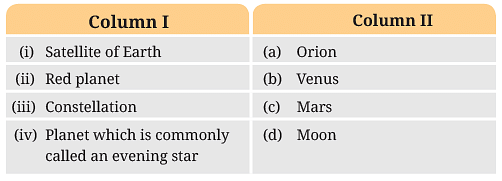
Ans:
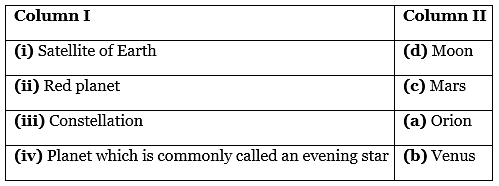
Q2: (i) Solve the following riddle.
My first alphabet is in MAN but not in CAN
My second alphabet is in ACE and also in FAN
My third alphabet is in RAT and not in CAT
My fourth alphabet is in SUN but not in FUN
I am a planet that moves around the Sun.
Ans: MARS
(ii) Make two similar riddles by yourself.
Riddle 1:
My first alphabet is in CAT but not in BAT
My second alphabet is in HAT and also in FAT
My third alphabet is in RAT but not in MAT
My fourth alphabet is in SUN but not in FUN
I am a planet that moves around the Sun.
Answer: EARTH
Riddle 2:
My first alphabet is in JUPITER but not in SATURN
My second alphabet is in VENUS and also in MARS
My third alphabet is in EARTH but not in MOON
My fourth alphabet is in MARS but not in VENUS
I am a planet that moves around the Sun.
Answer: MARS
Q3: Which of the following is not a member of our Solar System?
(i) Sirius
(ii) Comets
(iii) Asteroids
(iv) Pluto
Ans: (i) Sirius
Q4: Which of the following is not a planet of the Sun?
(i) Jupiter
(ii) Pluto
(iii) Neptune
(iv) Saturn
Ans: (ii) Pluto
Q5: Which is the brighter star, the Pole Star or Sirius?
Ans: Sirius
Q6: An artist’s representation of the Solar System is given in Fig. 12.12. Is the order of the planets, correct? If not, write the correct order in the boxes in the figure.
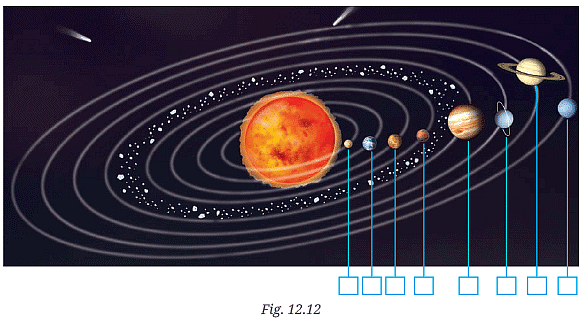
Ans: The order of the planets in the figure may not be correct. The correct order from the Sun is: Mercury, Venus, Earth, Mars, Jupiter, Saturn, Uranus, Neptune.
Q7: A portion of night sky with stars is shown in Fig. 12.13. Look carefully and identify the groups of stars that form the patterns—the Big Dipper and the Little Dipper. Draw lines to connect the stars for these patterns and label them. Also, identify and label the Pole Star. You may refer to Fig. 12.4 for help.
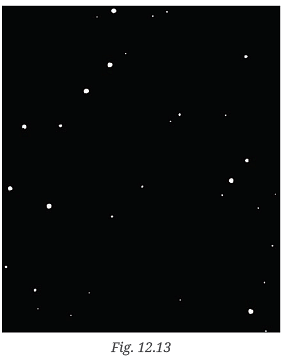
Ans: This would involve drawing lines on Fig. 12.13 to show the Big Dipper and Little Dipper and labelling the Pole Star.
Q8: A portion of the night sky is shown in Fig. 12.14. Draw lines to connect the stars for Orion and label the star Sirius. You may refer to Fig. 12.3.
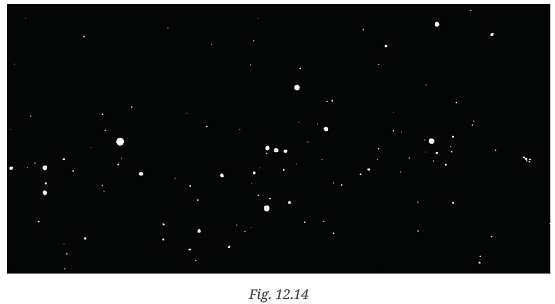
Ans: This would involve drawing lines on Fig. 12.14 to show Orion and labelling the star Sirius.
Q9: You can see stars fading away at dawn and appearing at dusk. During the day we do not see the stars. Explain why.
Ans: During the day, the Sun’s bright light outshines the stars, making them invisible to our eyes. The atmosphere scatters the sunlight, creating the blue sky and masking the faint light of the stars.
Q10: During a clear night, try to observe the Big Dipper 3–4 times at an interval of 2 to 3 hours. Also try to locate the Pole Star each time. Does the Big Dipper appear to move? Draw a rough sketch to illustrate this, mentioning the time in each case.
Ans: The Big Dipper appears to move around the Pole Star due to the rotation of the Earth. Over a few hours, its position changes, making it seem as if it is rotating around the Pole Star. [A sketch would be needed to show the different positions.
Q11: Think about the night sky and write a poem or a story on it.
Ans: This would be a creative exercise where students write their own poem or story about the night sky.

